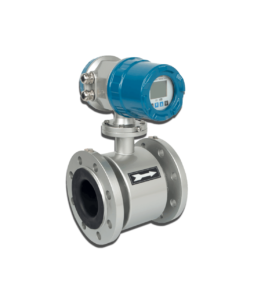Structurally, the sensor and converter form a whole, which is called an integrated electromagnetic flowmeter. The integrated electromagnetic flowmeter can reduce excitation and signal transmission cables during installation and use, save installation costs, and bring convenience to on-site operation and on-site instructions, and its instrument manufacturing cost is relatively low. Therefore, integrated electromagnetic flowmeters are often used in industrial production process control. However, the ambient temperature used by the integrated type is limited by the components of the converter and is generally not higher than 60°C, and the restriction on pipeline vibration is also more restrictive than that of the separated type. In addition, environmental conditions have also increased the requirements for the external brightness protection level of the converter, which generally needs to be above IP65.
The 4-20mA output signal of the two-wire electromagnetic flowmeter is stringed in the DC power supply circuit, and the excitation energy is also taken from the output current. The flowmeter has only two transmission cables, and the power line and signal output line are shared. The two-wire instrument can reduce the laying of cables, unify the power supply, save costs, and facilitate maintenance and management. Generally, the two-wire electromagnetic flowmeter adopts an integrated structure.

The excitation current of the two-wire electromagnetic flowmeter is small, and it is relatively easy to form an essential anti-corrosion structure.
The technical difficulty of the two-wire electromagnetic flowmeter is to solve the problem of low power consumption of the instrument. It requires that the working current of the instrument is not more than 4mA. As the excitation current of the sensor is reduced, the intensity of the magnetic field is reduced, and the induced flow signal is reduced. The sensor structure can use high permeability, low coercivity, and a new type of amorphous magnetic material as the core to reduce magnetic leakage, improve excitation efficiency and reduce the impact of temperature changes. The converter is required to select low-power devices and adopt pulse modulation isolation measures to provide different power supply voltages for analog circuits and digital circuits to improve its anti-interference performance.
The two-wire electromagnetic flowmeter is generally only suitable for small and medium diameters below DN200.
